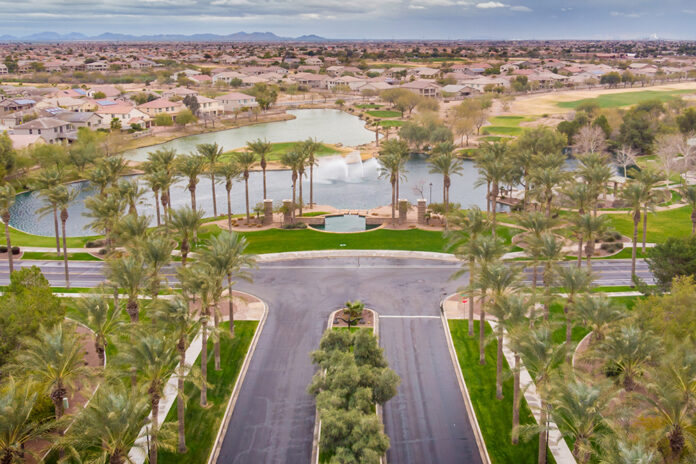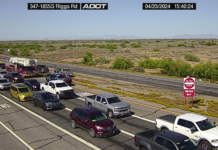
Maricopa has the water to grow, but it also has a plan.
“Maricopa has had tremendous growth in its early incorporation,” said Kazi Haque, Maricopa’s assistant director of Development Services.
Haque said one of the big hurdles the city has to jump is the flood plain, as it is holding up the construction of 2,000 to 3,000 homes that have been approved. The proposed homes sit in the flood plain.
Transportation corridors are another big concern highlighted in the city’s planning.
Also in the series Drought & Development
Overview
Councilman gives Arizona 30 years left to survive
O’Halleran: Drought means no shortage of water issues
Contingency plan bites into Pinal County agriculture
GWR touts strong water future
“We have been practicing sustainable development,” Haque said. “Our Vision 2040 that our council approved several years ago in 2015 gives us the overall vision of which direction the city needs to go. That was our citizen-driven vision process. These are the ideas we’ve gotten from the citizens, telling us what to do.”
Once the city has a vision it is written into the general plan.
“It gives everybody a blueprint of our physical development for the next 15-20 years,” he said. “These are state-required policies that we have to maintain. Every city and town of a general population has to have a plan,” Haque said.
He said the general plan is the only governing document that must be approved by the voters of a community.
“This is approved by the voters, and we hear what the voters want,” said City of Maricopa public information officer Adam Wolfe. “Each department develops their own strategic plan to achieve these goals. We model our next year or two based on these goals. We do take this to heart. This is what our citizens want, and this is what they have approved.”
One advantage of Maricopa being such a young city compared to most in Arizona is that the infrastructure is new and built with technology and the future in mind.
“When you can develop things from the start that are more efficient, you have a much more sustainable city,” said Wolfe.
Haque said planned growth is also more sustainable because a city can provide infrastructure like water more effectively when growth happens in an area, not “leap-frogging” around the city.
“We plan for it and make it more cohesive rather than fragmented,” Haque said adding, “You plan it but sometimes things go wrong. We try to be cognizant of those facts and educate our staff and ourselves all of the time. We are up to date on technology as well as the rules and regulations.”
Haque said Maricopa is one of the last areas around Phoenix that has large tracts of land available.
“In 2003, they were building homes out here, 60 miles away from the county seat,” Haque said. “There was no real oversight. They were just rapidly building homes. The founding fathers thought they better have control of this place, or it would just be another town out in the desert. That’s when they decided to create a city.”
Though Arizona remains in a long-term drought that has lasted more than 20 years, an assured water supply in Maricopa has prevented the serious concern its possible depletion has caused in the rest of the state. As a result, Haque said Maricopa has “great potential” for growth. The city’s planning area actually covers 270 square miles. In all, the city has the potential to add up to 250,000 residential homes if it actually builds out its planning area.
The city’s planning area goes as far south as Interstate 8.
Haque said planning for inside the city’s boundaries is one thing, but there are variables the city can’t control, namely road construction that connects Maricopa with the outside world.
“We have this vision. We have the resources set up,” Haque said. “You have to plan it in advance to make sure the infrastructure is in place. If we look at our projection in 2030 or 2040 or 2050, do we have adequate roads? Can they hold current traffic?”
Maricopa may plan their city, but they don’t own the roads leading to Phoenix, Chandler and Casa Grande.
“We need the resources right now,” Haque said. “When you talk outside the city limits you’re talking big money. If you’re talking about east-west corridors and that kind of stuff to Casa Grande and I-10, we’re talking about a lot of money.”
Wolfe said inside the city “we’re in very good shape. We have the plan and we have the natural resources in place like water. The only thing that limits potentially Maricopa from growing is roads. It is access to the city. When you go out of the city limits, we don’t control the roads.”
Wolfe said the City of Maricopa is working with its partners, the state of Arizona and the Gila River Indian Community to make needed improvements take place.
“If you get 160,000 people here by 2050, you have to make sure they can access other areas,” Wolfe said.



![Maricopa’s ‘TikTok Rizz Party,’ explained One of several flyers for a "TikTok rizz party" is taped to a door in the Maricopa Business Center along Honeycutt Road on April 23, 2024. [Monica D. Spencer]](https://www.inmaricopa.com/wp-content/uploads/2024/04/spencer-042324-tiktok-rizz-party-flyer-web-218x150.jpg)









![Alleged car thief released without charges Phoenix police stop a stolen vehicle on April 20, 2024. [Facebook]](https://www.inmaricopa.com/wp-content/uploads/2024/04/IMG_5040-218x150.jpg)


![Maricopa’s ‘TikTok Rizz Party,’ explained One of several flyers for a "TikTok rizz party" is taped to a door in the Maricopa Business Center along Honeycutt Road on April 23, 2024. [Monica D. Spencer]](https://www.inmaricopa.com/wp-content/uploads/2024/04/spencer-042324-tiktok-rizz-party-flyer-web-100x70.jpg)
